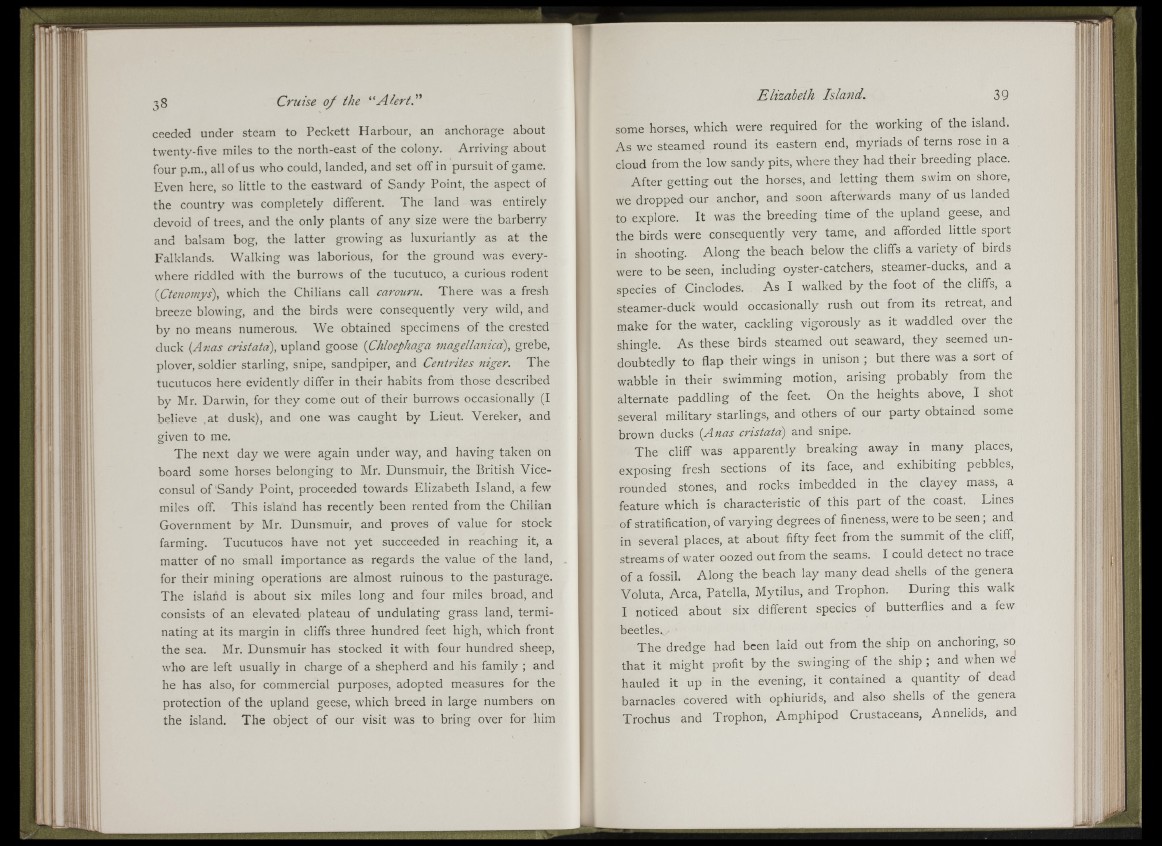
!
Cruise of the “ Ale rtP
ceeded under steam to Peckett Harbour, an anchorage about
twenty-five miles to the north-east of the colony. Arriving about
four p.m., all of us who could, landed, and set off in pursuit of game.
Even here, so little to the eastward of Sandy Point, the aspect of
the country was completely different. The land was entirely
devoid of trees, and the only plants of any size were tne barberry
and balsam bog, the latter growing as luxuriantly as at the
Falklands. Walking was laborious, for the ground was everywhere
riddled with the burrows of the tucutuco, a curious rodent
{Ctenomys), which the Chilians call carouru. There was a fresh
breeze blowing, and the birds were consequently very wild, and
by no means numerous. We obtained specimens of the crested
duck {Anas cristata), upland goose {Chloephaga magellanica), grebe,
plover, soldier starling, snipe, sandpiper, and Centrites niger. The
tucutucos here evidently differ in their habits from those described
by Mr. Darwin, for they come out of their burrows occasionally (I
believe at dusk), and one was caught by Lieut. Vereker, and
given to me.
The next day we were again under way, and having taken on
board some horses belonging to Mr. Dunsmuir, the British Vice-
consul of Sandy Point, proceeded towards Elizabeth Island, a few
miles off. This island has recently been rented from the Chilian
Government by Mr. Dunsmuir, and proves of value for stock
farming. Tucutucos have not yet succeeded in reaching it, a
matter of no small importance as regards the value of the land,
for their mining operations are almost ruinous to the pasturage.
The island is about six miles long and four miles broad, and
consists of an elevated plateau of undulating grass land, terminating
at its margin in cliffs three hundred feet high, which front
the sea. Mr. Dunsmuir has stocked it with four hundred sheep,
who are left usually in charge of a shepherd and his family ; and
he has also, for commercial purposes, adopted measures for the
protection of the upland geese, which breed in large numbers on
the island. The object of our visit was to bring over for him
Elizabeth Island. 39
some horses, which were required for the working of the island.
As we steamed round its eastern end, myriads of terns rose in a
cloud from the low sandy pits, where they had their breeding place.
After getting out the horses, and letting them swim on shore,
we dropped our anchor, and soon afterwards many of us landed
to explore. It was the breeding time of the upland geese, and
the birds were consequently very tame, and afforded little spoit
in shooting. Along the beach below the cliffs a variety of birds
were to be seen, including oyster-catchers, steamer-ducks, and a
species of Cinclodes. As I walked by the foot of the cliffs, a
steamer-duck would occasionally rush out from its retreat, and
make for the water, cackling vigorously as it waddled over the
shingle. As these birds steamed out seaward, they seemed undoubtedly
to flap their wings in unison ; but there was a sort of
wabble in their swimming motion, arising probably from the
alternate paddling of the feet. On the heights above, I shot
several military starlings, and others of our party obtained some
brown ducks {Anas cristata) and snipe.
The cliff was apparently breaking away in many places,
exposing fresh sections of its face, and exhibiting pebolcs,
rounded stones, and rocks imbedded in the clayey mass, a
feature which is characteristic of this part of the coast. Lines
of stratification, of varying degrees of fineness, were to be seen ; and
in several places, at about fifty feet from the summit of the cliff,
streams of water oozed out from the seams. I could detect no tiace
of a fossil. Along the beach lay many dead shells of the genera
Voluta, Area, Patella, Mytilus, and Trophon. During this walk
I noticed about six different species of butterflies and a few
beetles.,/
The dredge had been laid out from the ship on anchoring, so
that it might profit by the swinging of the ship ; and when we
hauled it up in the evening, it contained a quantity of dead
barnacles covered with ophiurids, and also shells of the genera
Trochus and Trophon, Amphipod Crustaceans, Annelids, and
¡' li
mbi'
:ri
I
m
a